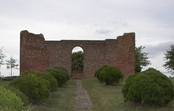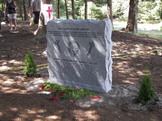 Travel by ancestry adds a new dimension to planning a vacation. With a search for ancestry as a primary focus, a vacation can span days, weeks, even centuries! A trip to Maryland's Eastern Shore, can include a stop in the 18th century, with a visit to the White Marsh Episcopal Church (circa 1690). You'll find the ruins of the old church just outside of the historic port town of Oxford, Maryland, on Route 50. Take a short walk from your car to the 14th of December, 1755, when port master Henry Callister and his friend, The Reverend Thomas Bacon, took up a special collection and pleaded with Oxford's plantation families to help the 263 starving and destitute Acadian exiles just recently arrived on Oxford's docks, from Nova Scotia, Canada. Click here for more of this story.  Travel by ancestry adds a new dimension to planning a vacation. With a search for ancestry as a primary focus, a vacation can span days, weeks, even centuries! At Vermilionville Living History Museum and Folklife Park in Lafayette, Louisiana, find out how Acadian culture (and two story homes) survive centuries of living; connect with early Acadian heritage, history (and music!) of eighteenth-century Louisiana. In a garden at Vermilionville, a chameleon who makes his home in a branch of a tree, changes his color from the bright green of an adjoining leaf to the dark brown of his perch in a matter of seconds -- much like how Acadian ancestors, on arrival in Louisiana in the late 1760s, quickly adapted to suit their surroundings. At Vermilionville, an ensemble of musicians plays traditional Cajun music. Strong on strings, fiddlers take the lead, there's an accordion section, and a galvanized steel bucket, carries a significant part of the melody. Click here for more of this story.  Travel by ancestry adds a new dimension to planning a vacation. With a search for ancestry as a primary focus, a vacation can span days, weeks, even centuries! At La Have, Nova Scotia, the headwaters of an Mikmaq-Acadian heritage and culture, travel by ancestry holds special significance for those who search for indigenous Mi'kmaq-Acadian roots. A drive to Petite Riviere might begin at nine in the morning and end in the seventeenth century -- at an ancient Mi'kmaq - Acadian burial ground. Follow a winding path through a farmer's field; and there, in a clearing, you may encounter a granite stone, guarded by a lone white horse -- the familiar surnames of founding ancestors, who lived nearly four hundred years ago, carved into its surface. Click here for more of this story. |
Archives
June 2025
Categories
All
|
DNA-Genealogy-History.com Site Index:
Copyright 2025 Marie Rundquist., DNA Genealogy History, LLC
DNA Genealogy History, LLC is a registered S Corporation with the State of Virginia and the Federal Government since 2017, is a retailer and distributor of books and digital publications, and is certified, authorized and empowered to collect Sales and Use Tax for the Commonwealth of Virginia.
E-Mail Your Comments to [email protected]
This website is not intended for users located within the European Economic Area.
DNA Genealogy History, LLC is a registered S Corporation with the State of Virginia and the Federal Government since 2017, is a retailer and distributor of books and digital publications, and is certified, authorized and empowered to collect Sales and Use Tax for the Commonwealth of Virginia.
E-Mail Your Comments to [email protected]
This website is not intended for users located within the European Economic Area.




 RSS Feed
RSS Feed
